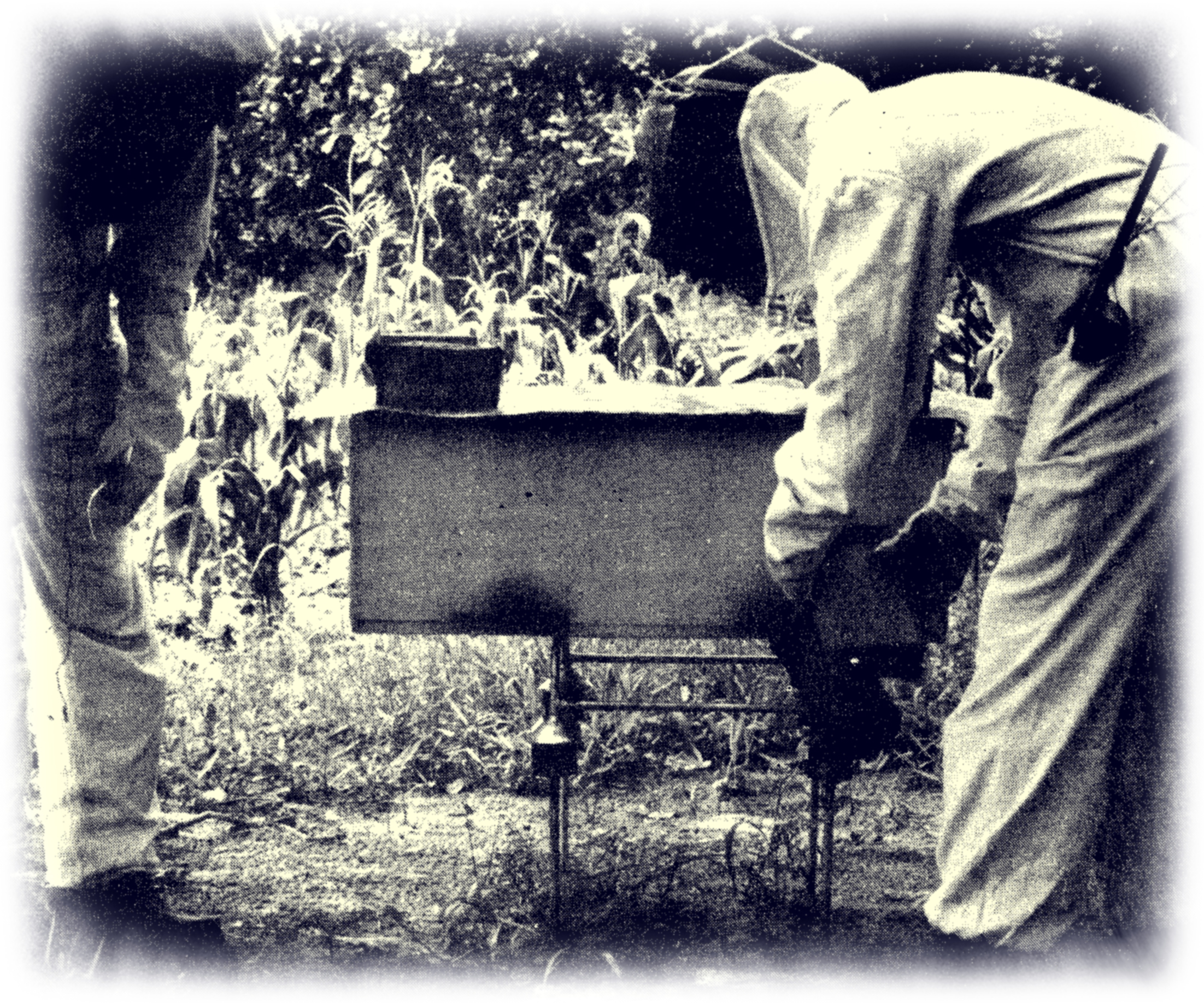Agriculture in Mozambique:
Bee-Keeping (Apiculture), 1985-1995
Unnumbered Dossier

Above: Bee-keepers wearing protective clothing working with a modern hive.
Despite attempts to build on its much trumpeted commercial potential, the development of apicultural practices in Mozambique was not accompanied by necessary investment in packing or marketing in the 1980s and 1990s. Much rural honey production was informal and community-based and remained so through the 1980s and 1990s.
We know very little about bee-keeping before the arrival of the Portuguese colonialists. There are, however, references in the publications of Dr José João Ferreira Alcobia to the keeping of beehives in Mocuba, Sussundenga (Manica Province) and Matola in the 1940s and 1950s. Additionally, in the 1950s the Missão Zoológico de Moçambique (replaced in 1963 by the Missão dos Estudos Zoológicos do Ultramar) introduced movable beehives constructed of cork. After independence in 1975, a national programme was established in 1982 with FAO support, and Eng. Alcobia was appointed its director (see e.g. his publications Criação de abelhas (Maputo. 1988), and Manual prático de apicultura (Bissau, 1993). The programme fell under the Directorate of Forests and Wildlife.
In the years between 1982 to 1994, support for beekeeping remained active, and sources indicate that by the mid-1990s there were around 3,000 trained bee-keepers in the country, graduates of a training centre in Marracuene. A processing plant for honey was established in Matola, and by the mid-1980s cork hives had been replaced by Langstroth-type hives with vertically hung frames. The national programme ended in 1994, since when support has passed to the domain of the NGO sector and some international donors.
More recently, however, projects to develop the sector and even to export honey products have been initiated, with accompanying investment in both beekeeping and honey production itself. A technical study published in 2018 identified eight principal types of Mozambican honey through a chemical analysis of the pollen collected by the bees which produced it. The authors commented that
… there is an almost total lack of scientific data… Pollen spectrum more than geographical origin permits distinguishing different types of honey from Mozambique. Not only vegetation but also the apicultural practices contribute to the variability… All this confers a certain singularity to honeys that belong to the same group… [and] highlights the importance of beekeeping practices in improving the quality of Mozambican honey… having a good knowledge of the environmental and human implications… is of great help to propose a program of future actions when the apiculture wants to be exploited more thoroughly… (Fernando Tanleque-Albertoa and others, “Quality parameters, pollen and volatile profiles of honey from north and central Mozambique," Food Chemistry, 2018).
Apart from what might be called the modern sector, in the miombo woodlands of southern Africa, including Mozambique, honey is gathered by local people from cavities in trees as well as produced through the management of artesanal beehives. In a study of honey-gathering published in 2019 the authors argued that the practices of felling and stripping bark from trees were environmentally damaging:
Current practices involve killing trees and can cause uncontrolled fires, affecting villages, animals and trees. … wild honey is gathered from natural cavities in a diversity of tree species, typically by felling the tree… techniques are destructive and primarily target larger trees… For nine species [of tree], felling and debarking were found to have reduced the number of larger trees by between 40% and 100%... diminishing the nectar resource, the number of bee colonies, and the number of trees suitable for wild hives (Natasha Sofia Ribeiro and others, “Gathering honey from wild and traditional hives in the Miombo woodlands of the Niassa National Reserve, Mozambique: What are the impacts on tree populations?” Global Ecology and Conservation (2019).
![]()
Consolidated Downloadable Zipped Files
Click on the yellow folder image below to download a zipped archive of 25 press clippings in PDF format.
![]()



![Aluka: Struggles for Freedom [subscription required] Struggles for Freedom](imgs/aluka_200.png)



